Kunze 1817
What is Chaetomium?
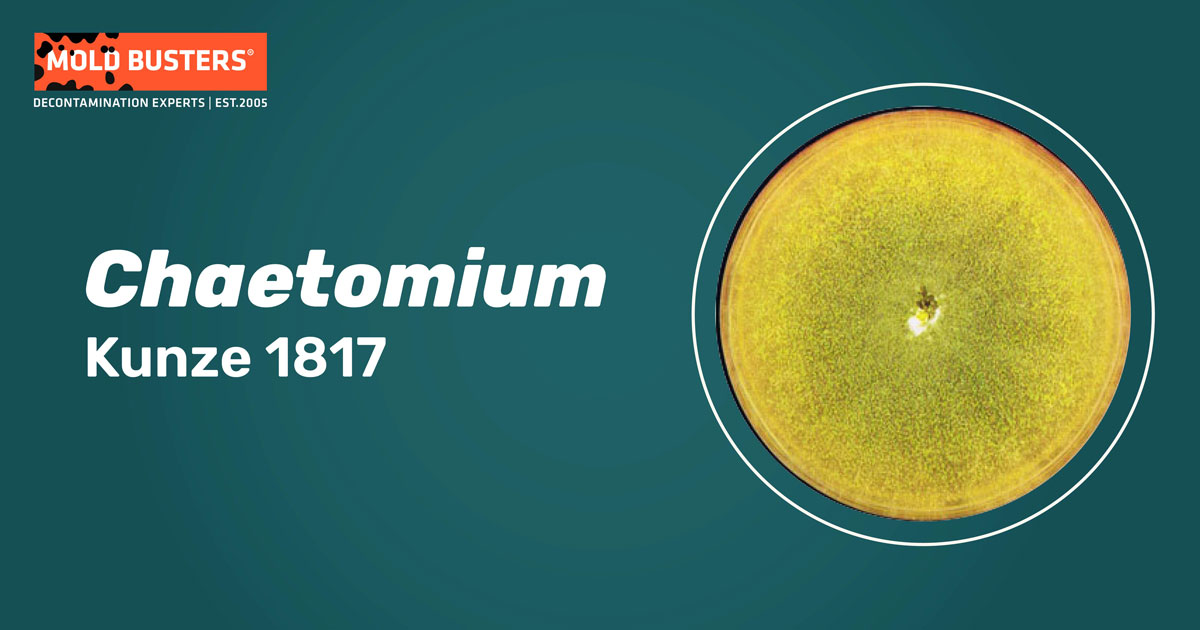
Chaetomium is a genus of mold fungi with the ability to colonize many different substrates. Outdoors, they can be commonly found in soil, compost, and plant debris. Chaetomium’s ability to degrade cellulose makes them frequent colonizers on various indoor-building materials, such as planks, wallpapers, and gypsum walls. They are known to produce a variety of bioactive and volatile metabolites, thereby producing strong dusty smells, especially in water-damaged building materials.
What are Chaetomium species?
There are approximately 90 recognized species strictly in the genus Chaetomium, while broadly speaking, around 400 fungi have been described in Chaetomium. Several of these species have been reported to be allergenic or pathogenic. The most commonly occurring species is C. globosum, followed by C. atrobrunneum, C. funicola, and C. strumarium [13].
Chaetomium morphology
The fruiting bodies (ascocarps) that Chaetomium spp. produce are of perithecia type (flask-shaped hollow ascocarp), with an opening (ostiole) through which the ascospores are released (Fig. 1). Ascospores (sexual fungal spores) produced by the fungi from the Chaetomium genus are often freed from the ascus (a sack-like structure containing spores) before being discharged singly from the fruiting body, and hence could be mistaken for conidia (which are produced asexually). Chaetomium spp. produce characteristic dark hyphae attached to the fruiting body walls, which are clearly visible under the low power microscope (Fig. 2) [14].
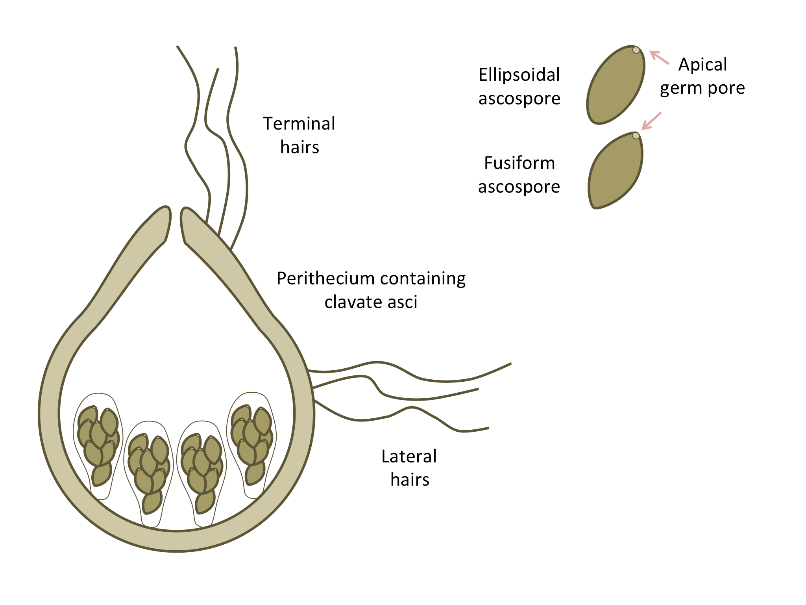
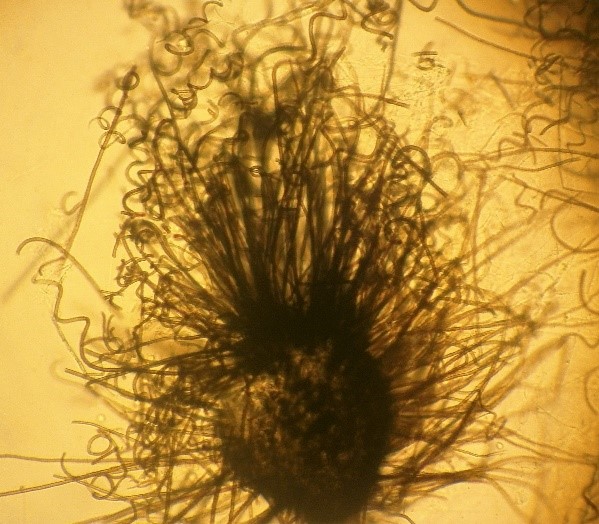
How does Chaetomium mold appear?
Chaetomium is common mesophilic fungi with a worldwide distribution. Like most mold species, Chaetomium spp. reproduces through airborne spores. Once these spores land in a suitable environment, they quickly germinate and begin to develop into a colony. Indoor mold colonies are likely to appear in damp and humid areas or areas that have previously suffered water damage. They grow well on cellulose-containing materials, such as drywall, wallpaper, and wood.
The temperature they can grow at depends on the species but ranges from 15°C to 55°C (59–131°F). Most species develop optimally between 25°C and 35°C (77–95°F). They require a water activity above 0.90 [2]. These fungi can easily dissolve the cellulose fibers contained in materials such as paper and cotton, thus breaking apart the materials themselves. This process is even faster under high humidity conditions.
Chaetomium mold statistics
As part of the data analysis presented inside our Mold Statistics resource page, we have calculated how often mold spore types appear in different parts of the indoor environment when mold levels are elevated. Below are the stats for Chaetomium:
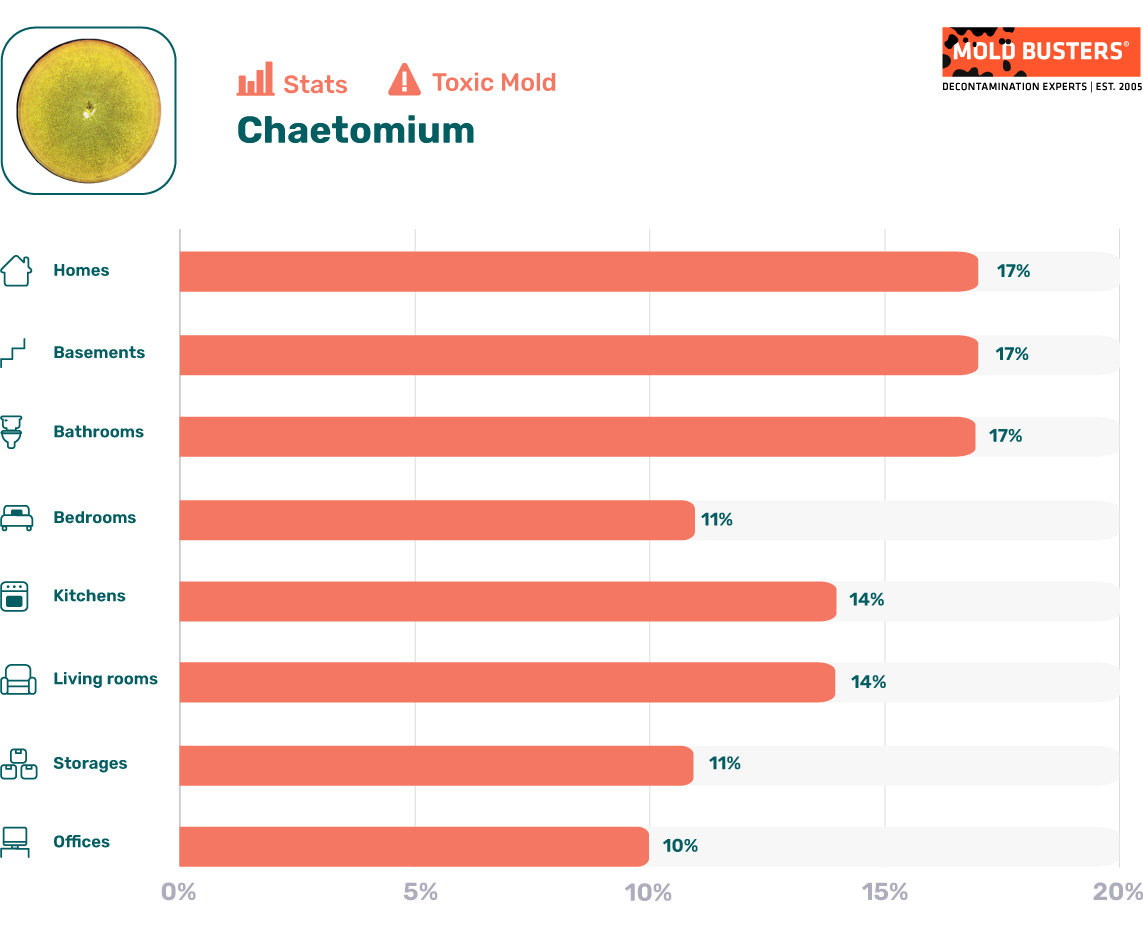

Is Chaetomium mold toxic?
Chaetomium molds produce several mycotoxins, including sterigmatocystin, O-methylsterigmatocystin, chaetochromin, chaetocin, chetomin, cochliodinols, and mollicellin G [3]. Many of these compounds have been reported to have teratogenic and carcinogenic effects. Chaetoglobsins A and C, secreted by C. globosum, are reported to be produced in building materials.
Not much is known about Chaetomium mycotoxicosis in humans, but animal studies have shown that contaminated cereals are extremely toxic and potentially fatal when fed to animals [5, 6]. Furthermore, a study has shown that Chaetomium extracts are toxic to the spleen, liver, and kidneys of mice [7].
What are Chaetomium mold health effects?
Many types of mold, including Chaetomium molds, can lead to adverse health effects if not dealt with on time. Problems usually occur due to an excessive concentration of fungal spores in the surrounding air. Chaetomium spp. is reported to be allergenic, and several species have been associated with hay fever, asthma, and allergic sinusitis [7].
Chaetomium molds are often the cause of skin and nail infections (onychomycosis) [8]. C. globosum and C. atrobrunneum have been known to cause pulmonary mycosis, severe brain abscesses, and fatal cerebral infections. However, these cases occurred in immunocompromised patients due to an underlying disease or immunosuppressive treatment and in intravenous drug users [9].
There is also evidence suggesting that exposure to Chaetomium molds may increase the risk of permanent neurological damage of the myelin sheath. This is also why autoimmune diseases such as lupus and multiple sclerosis have also been linked to the exposure of Chaetomium mold [10].
What are Chaetomium mold symptoms?
Symptoms that result from Chaetomium spp. exposure depends on the organs that have been affected. Symptoms of respiratory issues related to Chaetomium spp. include coughing, cold and flu symptoms, and rhinitis. Symptoms of severe internal infections may include memory loss, balance issues, nose bleeds, dermatitis, acid reflux, headaches, seizures, internal lesions, fever, and general malaise. Symptoms of onychomycosis are more visible and include the thickening and discoloration of the nails, making them brittle or crumble easily. The area around the nail may also be tender or painful, and there may also be an unpleasant smell [11, 12]
Where can you find Chaetomium mold in the house?
In houses, Chaetomium molds are mostly found in areas that have been damaged by water, such as leaking roofs, damp basements, leaky pipes, or areas around the sink (Fig. 3). They can also be found in the areas surrounding the households, such as gardens and composts.
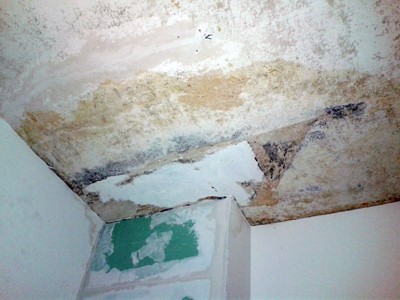
How to remove Chaetomium mold?
Chaetomium molds can be hazardous to health and therefore need to be removed as soon as possible. The longer the mold remains in your house, the more likely it will spread to other locations, making cleanup more extensive and expensive. Furthermore, the longer exposure to the mold, the more likely adverse health issues related to Chaetomium might arise.
Chaetomium molds tend to grow in places that are difficult to see, such as inside walls, under carpets, and inside air conditioning ducts. To ensure that fungal colonies are located and removed from all areas, the best thing to do is to call a mold removal expert to inspect your home.
An experienced mold removal professional will locate all the areas in your home that contain mold and correctly advise you on what needs to be done next. Additionally, our experts can answer any other questions you may have about mold and also give you an estimate of how much it will cost to have the mold in your home professionally removed.
References
- Hawksworth DL, Lücking R (2017). Fungal Diversity Revisited: 2.2 to 3.8 Million Species. Microbiol Spectr. 5(4).
- d’Halewyn MA, Chevalier P (2019). Chaetomium spp. Retrieved from here.
- Sekita S, Yoshihira K, Natori S, Udagawa S, Muroi T, Sugiyama Y, Kurata H, Umeda M. (1981) Mycotoxin production by Chaetomium spp. and related fungi. Can J Microbiol. 27(8):766-72.
- Manning RO, Wyatt RD (1984). Comparative toxicity of Chaetomium contaminated corn and various chemical forms of oosporein in broiler chicks. Poult Sci. 63(2): 251-259.
- Christensen CM, Nelson GH, Mirocha CJ, Bates F, Dorworth CE (1966). Toxicity to rats of corn invaded by Chaetomium globosum. Appl Microbiol. 14(5): 774-777.
- Gupta J, Pathak B, Sethi N, Vora VC (1981). Histopathology of Mycotoxicosis produced in Swiss albino mice by metabolites of some fungal isolates. Appl Environ Microbiol. 41(3): 752-757.
- Burge HA (1985). Fungus allergens. Clin Rev Allergy. 3(3): 319-329.
- Stiller MJ, Rosenthal S, Summerbell RC, Pollack J, Chan A (1992). Onychomycosis of the toenails caused by Chaetomium globosum. J Am Acad Dermatol. 26(5/1): 775-776.
- Howard DH (2003). Pathogenic Fungi in Humans and Animals. Marcel Dekker, New York. pp 652-654.
- Lillard S (2004). Chaetomium. Retrieved from mold-help.org.

Get Special Gift: Industry-Standard Mold Removal Guidelines
Download the industry-standard guidelines that Mold Busters use in their own mold removal services, including news, tips and special offers:

Written by:
John Ward
Account Executive
Mold Busters
Edited by:
Dusan Sadikovic
Mycologist – MSc, PhD
Mold Busters
